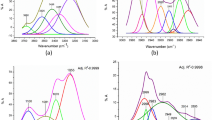Abstract
The enthalpy of formation of liquid 4-pentenoic acid was determined by combustion calorimetry. The vapor pressure and enthalpy of vaporization of the compound were measured by the transfer method over the temperature range 289–324 K. Conformational analysis was performed. The equilibrium structure, fundamental vibrations, moments of inertia, and total energy of the stablest acid conformers were calculated by the B3LYP/6-311G(d, p) and G3MP2 quantum-chemical methods. The experimental IR spectrum and calculated vibrational frequencies were used to assign IR bands. The thermodynamic properties of monomeric 4-pentenoic acid in the ideal gas state were calculated over the temperature range 0–1500 K. Additive and quantum-chemical methods were used to estimate the Δf H°(g) and Δvap H° values. Close agreement between the calculation results and experimental data was obtained. It was shown that additive and quantum-chemical methods could be used for estimating the enthalpies of formation and vaporization of nonconjugated alkenoic acids.
Similar content being viewed by others

References
R. P. Listead and H. N. Rydon, J. Chem. Soc., p. 580 (1933).
L. J. P. Keffler, J. Soc. Chem. Ind. 55, 331 (1936).
E. Z. Schjanberg, Phys. Chem. 178, 274 (1937).
J. D. Cox and G. Pilcher, Thermochemistry of Organic and Organometallic Compounds (Academic, New York, 1970).
S. Sunner and M. Mansson, Experimental Chemical Thermodynamics, Vol. 1: Combustion Calorimetry (Pergamon, New York, 1979).
“Atomic Weights of the Elements 1995, IUPAC Comission on Atomic Weights and Isotopic Abundances,” Pure Appl. Chem. 68, 2339 (1996).
J. D. Cox, D. D. Wagman, and V. A. Medvedev, CODATA Key Values for Thermodynamics (Hemisphere, New York, 1989).
S. P. Verevkin, J. Chem. Eng. Data 45, 946 (2000).
D. Kulikov, S. P. Verevkin, and A. Heintz, J. Chem. Eng. Data 46, 1593 (2001).
M. J. Frisch, G. W. Trucks, H. B. Schlegel, et al., Gaussian 03, Revision B.04 (Gaussian. Inc., Pittsburg, PA, 2003).
http://www.aist.go.jp/RIODB/SDBS/ (National Institute of Advanced Industrial Science and Technology, Date of Access).
H. B. Schlegel, J. Velkovski, and M. D. Halls, Theor. Chem. Acc. 105, 413 (2001).
M. L. Frenkel, G. Ja. Kabo, K. N. Marsh, et al., Thermodynamics of Organic Compounds in the Gas State (Thermodynamics Research Center, College Station, TX, 1994), Vol. 1.
G. Ya. Kabo, G. N. Roganov, and M. L. Frenkel’, Thermodynamics and Equilibrium of Isomers (Izd. Universitetskoe, Minsk, 1986) [in Russian].
The Thermodynamic Tables: Non-Hydrocarbons (Thermodynamics Research Center, College Station, TX, 1991).
N. Cohen, J. Phys. Chem. Ref. Data 25(6), 1411 (1996).
L. A. Curtiss, P. C. Redfern, K. Raghavachari, et al., J. Chem. Phys. 110(10), 4703 (1999).
L. A. Curtiss, K. Raghavachari, P. C. Redfern, et al., J. Chem. Phys. 112(3), 1125 (2000).
J. P. Pedley, R. D. Naylor, and S. P. Kirby, Thermochemical Data of Organic Compounds (Chapman and Hall, London, 1986).
M. L. P. Leitao, H. Pilcher, Y. Meng-Yan, et al., J. Chem. Thermodyn. 22, 885 (1990).
Author information
Authors and Affiliations
Corresponding author
Additional information
Original Russian Text © V.N. Emel’yanenko, S.P. Verevkin, E.N. Burakova, G.N. Roganov, M.K. Georgieva, 2008, published in Zhurnal Fizicheskoi Khimii, 2008, Vol. 82, No. 9, pp. 1708–1714.
Rights and permissions
About this article
Cite this article
Emel’yanenko, V.N., Verevkin, S.P., Burakova, E.N. et al. The thermodynamic properties of 4-pentenoic acid. Russ. J. Phys. Chem. 82, 1521–1526 (2008). https://doi.org/10.1134/S0036024408090215
Received:
Published:
Issue Date:
DOI: https://doi.org/10.1134/S0036024408090215


